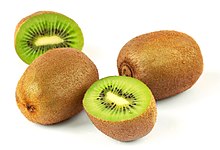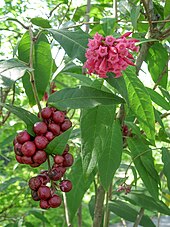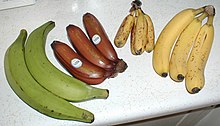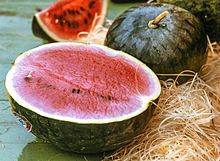Berry (botany)

In
Many berries are edible, but others, such as the
A plant that bears berries is said to be bacciferous or baccate[a] (from Latin bacca).
In everyday English, a "berry" is any small edible fruit. Berries are usually juicy, round, brightly coloured, sweet or sour, and do not have a stone or pit, although many small seeds may be present.[1]
Botanical berries


In
The nature of the endocarp distinguishes a berry from a drupe, which has a hardened or stony endocarp (see also below). The two kinds of fruit intergrade, depending on the state of the endocarp. Some sources have attempted to quantify the difference, e.g. requiring the endocarp to be less than 2 mm thick in a berry.[4]
Examples of botanical berries include:
- Avocado contains a single large seed surrounded by an imperceptible endocarp.[5] Avocados are, however, also sometimes classified as drupes.[6]
- Banana[7][8]
- Oregon-grape (Berberis aquifolium) and mayapple (Podophyllum spp.) (Berberidaceae)
- crowberry (Empetrum spp.) (family Ericaceae)
- Coffee berries (Rubiaceae) (also described as drupes)[9]
- Grossulariaceae), red, black, and white types
- Elderberry (Sambucus niger; Adoxaceae)
- Indian gooseberry (Phyllanthus emblica) (Phyllanthaceae)
- Garcinia mangostana (mangosteen) and Garcinia indica in the family Clusiaceae
- Sapodilla (Manilkara zapota), Sapotaceae[10]: 295
- Grape, Vitis vinifera in the family Vitaceae
- Honeysuckle: the berries of some species are edible and are called honeyberries, but others are poisonous (Lonicera spp.; Caprifoliaceae)
- Persimmon (Ebenaceae)[10]: 135
- Pumpkin, cucumber and watermelon in the family Cucurbitaceae[10]: 116
Modified berries

"True berries", or "baccae", may also be required to have a thin outer skin, not self-supporting when removed from the berry. This distinguishes, for example, a
Berries that develop from an inferior ovary are sometimes termed
Berry-like fruits
Many fruits commonly referred to as berries are not actual berries by the scientific definition, but fall into one of the following categories:
Drupes
Drupes are varyingly distinguished from botanical berries. Drupes are fleshy fruits produced from a (usually) single-seeded ovary with a hard woody layer (called the
Pomes
The pome fruits produced by plants in subtribe Pyrinae of family Rosaceae, such as apples and pears, have a structure (the core) in which tough tissue clearly separates the seeds from the outer softer pericarp.[15] Although pomes are not botanical berries, Amelanchier pomes become soft at maturity, resembling a blueberry, and are commonly called Juneberries, serviceberries or Saskatoon berries.[16]
Aggregate fruits
Aggregate or compound fruits contain seeds from different ovaries of a single flower, with the individual "fruitlets" joined at maturity to form the complete fruit.
Multiple fruits
Multiple fruits are not botanical berries. Multiple fruits are the fruits of two or more multiple flowers that are merged or packed closely together.
Accessory fruits
Accessory fruits are not botanical berries. In accessory fruits, the edible part is not generated by the ovary. Berry-like examples include:
- Strawberry – the non-fleshy aggregate of seed-like achenes on its exterior is actually the "fruit", derived from an aggregate of ovaries; the fleshy part develops instead from the receptacle.
- Mock strawberry(Duchesnea indica) – structured just like a strawberry.
- Sea grape (Coccoloba uvifera; Polygonaceae) – the fruit is a dry capsule surrounded by fleshy calyx.
Berry-like conifer seed cones

The female seed cones of some conifers have fleshy and merged scales, giving them a berry-like appearance. Juniper "berries" (family Cupressaceae), in particular those of Juniperus communis, are used to flavour gin. The seed cones of species in the families Podocarpaceae and Taxaceae have a bright colour when fully developed, increasing the resemblance to true berries. The "berries" of yews (Taxus species) consist of a female seed cone with which develops a fleshy red aril partially enclosing the poisonous seed.[citation needed]
History of terminology

The Latin word baca or bacca (plural baccae) was originally used for "any small round fruit".
In 1751, Carl Linnaeus wrote Philosophia Botanica, considered to be the first textbook of descriptive systematic botany.[25] He used eight different terms for fruits, one of which was bacca or berry, distinguished from other types of fruit such as drupa (drupe) and pomum (pome).[26] A bacca was defined as "pericarpium farctum evalve, semina ceteroquin nuda continens", meaning "unvalved solid pericarp, containing otherwise naked seeds".[27] The adjective "farctus" here has the sense of "solid with tissue softer than the outside; stuffed".[28] A berry or bacca was distinguished from a drupe and a pome, both of which also had an unvalved solid pericarp; a drupe also contained a nut (nux) and a pome a capsule (capsula), rather than the berry's naked seeds.[27] Linnaeus' use of bacca and pomum was thus significantly different from that of Caesalpinus. Botanists continue to differ on how fruit should be classified.[26]
Joseph Gaertner published a two-volume work, De Fructibus et Seminibus Plantarum (on the fruits and seeds of plants) between 1788 and 1792. In addition to Linnaeus' eight terms, he introduced seven more, including pepo for the berry-like fruits of cucurbits.[26] A pepo was distinguished by being a fleshy berry with the seeds distant from the axis, and so nearer the fruit wall[29] (i.e. by having "parietal placentation" in modern terminology). Nicaise Auguste Desvaux in 1813 used the terms hesperidium and amphisarca as further subdivisions of berries.[26] A hesperidium, called by others bacca corticata (berry with a cortex), had separate internal compartments ("loges" in the original French) and a separable membraneous epicarp or skin. An amphisarca was described as woody on the outside and fleshy on the inside.[30] "Hesperidium" remains in general use, but "amphisarca" is rarely used.[26]
There remains no universally agreed system of classification for fruits, and there continues to be "confusion over classification of fruit types and the definitions given to fruit terms".[26]
Evolution and phylogenetic significance

By definition, berries have a fleshy, indehiscent pericarp, as opposed to a dry, dehiscent pericarp.
Fruit type has been considered to be a useful character in classification and in understanding the
When fruits described as berries were studied in the family
Uses
Culinary



Berries, defined loosely, have been valuable as a food source to humans since before the start of agriculture,[citation needed] and remain among the primary food sources of other primates. Botanically defined berries with culinary uses include:
- Berries in the strictest sense: including bananas and plantains, blueberries, cranberries, coffee berries, gooseberries, red-, black- and white currants, tomatoes, grapes and peppers (Capsicum fruits)
- Hesperidia: citrus fruits, including oranges, lemons and limes
- Pepos: cucurbits, including squashes, cucumbers, melons and watermelons
Some berries are brightly coloured, due to
Some spices are prepared from berries. Allspice is made from the dried berries of Pimenta dioica.[38] The fruits (berries) of different cultivars of Capsicum annuum are used to make paprika (mildly hot), chili pepper (hot) and cayenne pepper (very hot).[39]
Others
Pepos, characterized by a hard outer rind, have also been used as containers by removing the inner flesh and seeds and then drying the remaining exocarp. The English name of Lagenaria siceraria, "bottle gourd", reflects its use as a liquid container.[40]
Some true berries have also been used as a source of dyes. In Hawaii, these included berries from a species of Dianella, used to produce blue, and berries from black nightshade (Solanum americanum), used to produce green.[41]
History
Cucurbit berries or pepos, particularly from Cucurbita and Lagenaria, are the earliest plants known to be domesticated – before 9,000–10,000 BP in the Americas, and probably by 12,000–13,000 BP in Asia.[40] Peppers were domesticated in Mesoamerica by 8,000 BP.[42][43] Many other early cultivated plants were also berries by the strict botanical definition, including grapes, domesticated by 8,000 BP[44][45] and known to have been used in wine production by 6,000 BP.[46]
Bananas were first domesticated in
The history of cultivated citrus fruit remains unclear, although some recent research suggests a possible origin in Papuasia rather than continental southeast Asia. Chinese documents show that mandarins and pomelos were established in cultivation there by around 4,200 BP.[49]
Commercial production



According to FAOSTAT data, in 2013 four of the five top fruit crops in terms of world production by weight were botanical berries. The other was a pome (apples).[Note 1]
| Name | Thousands of tonnes | Fruit type |
|---|---|---|
| Bananas & plantains | 144,592 | Berry |
| Citrus fruit† | 135,761 | Berry (hesperidium) |
| Watermelons | 109,279 | Berry (pepo) |
| Apples | 80,823 | Pome |
| Grapes | 77,181 | Berry |
†Citrus fruit includes, but is not limited to, oranges, lemons, limes, grapefruit (including pomelos), tangerines, mandarins, clementines and satsumas. Oranges make up 53% of the total.
According to FAOSTAT, in 2001, bananas (including plantains) and citrus comprised over 25% by value of the world's exported fruits and vegetables, citrus fruits being more valuable than bananas.[51] Export quantities of fruit are not entirely comparable with production quantities, since slightly different categories are used. The top five fruit exports by weight in 2012 are shown in the table below. The top two places are again occupied by bananas and citrus.[Note 2]
| Name | Thousands of tonnes | Fruit type |
|---|---|---|
| Bananas & plantains | 19,725 | Berry |
| Citrus fruit† | 15,262 | Berry (hesperidium) |
| Apples | 8,271 | Pome |
| Prepared fruit‡ | 7,120 | – |
| Grapes | 4,051 | Berry |
†Citrus fruit includes oranges, lemons, limes, grapefruit (including pomelos), tangerines, mandarins, clementines and satsumas. Oranges make up 43% of the total.
‡Prepared fruit here is "fruit, nuts and peel, including frozen, prepared or preserved, jam, paste, marmalade, purée and cooked fruits, other than those listed separately".[52]
See also
Notes
- ^ A fruit that resembles a berry, whether it actually is one or not, can also be called "baccate".
- ^ Production Quantity data for 2013 for the World total for all items was downloaded to a spreadsheet from FAOSTAT.[50] Items coded 486 to 626, corresponding to fruit, were retained. Data for bananas and plantains were combined, as these are not distinguished by all countries. Data for all citrus fruits were also combined, since some countries provide data under a general heading of "citrus fruit". The resulting table was then sorted and the top five entries used.
- ^ Export Quantity data for 2012 for the World total for all items was downloaded to a spreadsheet from FAOSTAT.[50] As for production, items coded 486 to 626 (but now excluding 564 wine, not present in the production data) were retained. Data for bananas and plantains were combined, as was data for all citrus fruits. The resulting table was then sorted and the top five entries used.
References
- ^ "Berry". Merriam-Webster. 21 January 2024.
- ^ Kiger, Robert W. & Porter, Duncan M. (2001). "Find term 'berry'". Categorical Glossary for the Flora of North America Project. Retrieved 14 August 2015.
- ^ Pabón-Mora & Litt (2011), p. 1417.
- ^ ISBN 978-1-84246-422-9.
- ^ Storey, W. B. (1973). "What kind of fruit is the avocado?". California Avocado Society 1973–74 Yearbook. 57: 70–71.
- ^ Wofford, B. Eugene. "Persea". In Flora of North America Editorial Committee (ed.). Flora of North America (online). eFloras.org. Retrieved 30 May 2019.
- ^ Morton, Julia. "Banana". Fruits of Warm Climates. Hort.purdue.edu. Archived from the original on 15 April 2009. Retrieved 16 April 2009.
- ^ Armstrong, Wayne P. "Identification Of Major Fruit Types". Wayne's Word: An On-Line Textbook of Natural History. Archived from the original on 20 November 2011. Retrieved 17 August 2013.
- ^ . "fruit a berry containing two (rarely one) seeds"
- ^ ISBN 978-1-55407-206-4.
- ^ a b c d e Spjut, Richard W. "Classification of Fruit Types". A Systematic Treatment of Fruit Types. The World Botanical Associates. Archived from the original on 29 March 2015. Retrieved 16 August 2015.
- ISBN 978-81-7133-896-2.
- ^ Kiger, Robert W. & Porter, Duncan M. (2001). "Find term 'drupaceous'". Categorical Glossary for the Flora of North America Project. Retrieved 14 August 2015.
- ISBN 978-0-521-70772-5., p. 277
- ^ Kiger, Robert W. & Porter, Duncan M. (2001). "Find term 'pome'". Categorical Glossary for the Flora of North America Project. Retrieved 21 August 2015.
- ^ Campbell, Christopher S.; Burgess, Michael B. & Cushman, Kevin R. "Amelanchier". In Flora of North America Editorial Committee (ed.). Flora of North America (online). eFloras.org. Retrieved 21 August 2015.
- ^ Kiger, Robert W. & Porter, Duncan M. (2001). "Find term 'aggregate fruit'". Categorical Glossary for the Flora of North America Project. Retrieved 14 August 2015.
- ^ Lu, Lingdi & Boufford, David E. "Rubus". In Wu, Zhengyi; Raven, Peter H. & Hong, Deyuan (eds.). Flora of China (online). eFloras.org. Retrieved 21 August 2015.
- ISBN 978-0-19-217674-5.
- ^ "Annonaceae". Encyclopædia Britannica. Retrieved 22 August 2015.
- ^ Kiger, Robert W. & Porter, Duncan M. (2001). "Find term 'multiple fruit'". Categorical Glossary for the Flora of North America Project. Retrieved 14 August 2015.
- .
- ISBN 978-0-7153-1643-6. p. 376.
- ^ Vines, S.H. (1913). "Robert Morison and John Ray". In Oliver, F.W. (ed.). Makers of British Botany (Project Gutenberg EBook ed.). Cambridge University Press. Retrieved 18 August 2015.
- ^ Stearn (2004), p. 35.
- ^ a b c d e f Spjut, Richard W. "The Need for Standardized Meanings to Fruit Terms: An Historical Perspective". A Systematic Treatment of Fruit Types. The World Botanical Associates. Archived from the original on 29 March 2015. Retrieved 17 August 2015.
- ^ a b Linnaeus, Carl (1751). Philosophia botanica (in Latin). Stockholm, Amsterdam: R. Kiesewetter, Z. Chatelain. p. 53.
- ^ Stearn 2004, p. 411.
- ^ Gaertner, Joseph (1788–1792). De Fructibus et Seminibus Plantarum (in Latin). p. XCVII.
Pepo, qui vulgo majorem Cucurbitae fructum denotat, nobis generatim dicitur bacca carnosa, cuius loculamenta ab axi remota, et prope fructus peripheriam ita posita sunt, ut etiam semina, ejus parietibus affigantur. (a fleshy berry, whose locules are remote from the axis, and are so positioned near the periphery of the fruit, that as well as the seeds, they are affixed to its walls, is generally called by us 'pepo', which usually denotes the larger fruit of cucurbits)
- ^ Desvaux, N.A. (1813). "Essai sur les différens genres de fruits des plantes phanérogames". Journal de Botanique, appliqué a l'Agriculture, a la Pharmacie, a la Médecine, et aux Arts (in French). 2: 161–183.
- ^ PMID 12324525
- ^
- PMID 21875970
- ^ Wrolstad, R.E. (2001). "The Possible Health Benefits of Anthocyanin Pigments and Polyphenolics". Linus Pauling Institute, Oregon State University, Corvallis. Archived from the original on 7 July 2014. Retrieved 7 July 2014.
- S2CID 25573388.
- ^ "Guidance for Industry, Food Labeling; Nutrient Content Claims; Definition for "High Potency" and Definition for "Antioxidant" for Use in Nutrient Content Claims for Dietary Supplements and Conventional Foods" (PDF). U.S. Department of Health and Human Services, Food and Drug Administration, Center for Food Safety and Applied Nutrition. June 2008.
- .
- ISBN 978-0-85199-605-9. p. 122
- ^ Weiss (2002), p. 216.
- ^ PMID 16352716.
- ISBN 978-0-8248-0698-9. p. 13
- PMID 21628269.
- PMID 24753581.
- PMID 21245334.
- ^ Vergano, Dan. "Grapes domesticated 8,000 years ago". USA Today. Retrieved 17 August 2015.
- ^ "Oldest Winery Unearthed in Armenian Cave". Discovery News. Archived from the original on 2 June 2015. Retrieved 17 August 2015.
- ^ "Tracing antiquity of banana cultivation in Papua New Guinea". The Australia & Pacific Science Foundation. Archived from the original on 29 August 2007. Retrieved 18 September 2007.
- S2CID 10644185.
- S2CID 84685765.
- ^ a b "Download data". Food and Agriculture Organization of the United Nations Statistics Division (FAOSTAT). Retrieved 22 August 2015.
- ^ "Overview of World Banana Production and Trade". FAO.org. Retrieved 11 August 2015.
- ^ "Definition and Classification of Commodities: 8 Fruits and derived products". Food and Agriculture Organization of the United Nations. Archived from the original on 21 February 1997. Retrieved 22 August 2015.
